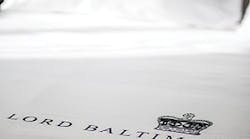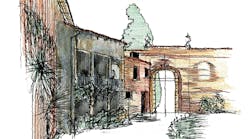Set in downtown Baltimore, the 440-room Lord Baltimore Hotel is a culturally significant landmark that is included in the National Register of Historic Places and is a member of the Historic Hotels of America. When Rubell Hotels acquired the property in March 2013, it was tired, worn out, and in need of a drastic update if it was going to succeed and hold its own in the marketplace.
“We love architectural treasures and opportunities that are invisible,” says Mera Rubell, partner with Rubell Hotels, on the opportunity to acquire the hotel. “We think history is an asset, so we bought the hotel and needed to do an intelligent renovation to provide affordable, unpretentious luxury.”
Luckily, the building itself was still full of its original charm and French Renaissance architectural details that could not be ignored. Embracing the historical significance while redesigning the hotel, interior designer Scott Sanders of Scott Sanders LLC and the Rubell family created a modern, contemporary feeling that highlights the space’s history and unique character.
“Our global vision is to let the old shine and bring in a layer of contemporary comfort,” Rubell says. “It’s a balancing act—what you leave, how you leave it, and how you express it in a contemporary way. This is the only grand hotel left in Baltimore that hasn’t been converted to a residence, so we took that very seriously.”
contemporary comfort
The redesign process began with prepping 440 guests rooms that required the longest lead time to get everything ordered, turned over, and staged. After a phone conversation about the project with Rubell and reviewing photos of the property, Sanders brainstormed ideas for their meeting, knowing the design needed a modern touch to make the hotel feel current and to bring people back into it.
“I had a color palette in the back of my head,” he says. “I was feeling gray, which has become such a beautiful neutral and works with so many other colors. It’s somewhat unexpected in a guest room.”
After previously working together on several other hotel and home design projects, Sanders and the Rubell family have had a long-lasting relationship and are comfortable with what each brings to the table. Being on the same page for the vision of the hotel allowed the project to progress very quickly. In fact, Sanders and Mera Rubell pulled together the design for the guest rooms in under an hour during their meeting.
“Within a half hour, there was just a beautiful palette of grays and blacks with a rich mahogany wood color for the furniture,” says Sanders. “We went from there and installed the model room in two weeks and there wasn’t a single change; it was so dead on, and everybody loved it.”
In addition, unique, contemporary artwork in each room adds a pop of color and contrast to the rich, modern color palette. And instead of picking artwork off the shelf, Rubell infused some of the family’s love for art into each room by having original works of art commissioned for the guest rooms. In total, there are 2,500 original works of art within the guest rooms and public spaces.
harmonizing with history
With the guest room design finalized, Sanders and Rubell moved down to the lobby, which features an ornate, detailed painted ceiling that is original to the building, as well as brass elevators, bronze railings, and gold details on the columns. The goal was to give the space a comfortable, contemporary feeling while retaining and showcasing the original elements.
“I really felt that the same palette that was in the guest rooms should be the driving force in the lobby, the cocktail lounge/bar, the business center, and the mezzanine, almost as if you were designing a home where you have a backdrop of a palette that runs through the house, and then when you get to special rooms, they have a different palette, but there’s still an underlying theme that creates a cohesiveness,” Sanders explains.
To create this sense of cohesiveness using the color palette as a common theme, they pulled the gray, black, and white from the rooms and then mixed in gold and brass to connect the contemporary colors brought in from the rooms with the historical elements they wanted to showcase. They also took the gray and black carpet from the guest rooms and reversed it for the center lobby, adding another level of cohesion.
PageBreak
Sanders further ensured that the lobby area has a comfortable, modern living room feeling by turning toward hospitality fabrics that were inspired by residential designs. For example, the ottomans in the space are covered in a faux-croc vinyl that is similar to a leather textile used in residential designs. To a similar effect, the sofas feature tweeds.
“There are a lot of twists where you have to look twice because at first glance it looks like someone’s living room or den, but then when you take a second glance and feel it, it feels very soft and sophisticated and is true hospitality,” Sanders says. “I wanted it to feel special, but at the same time it had to be functional."
The relaxed, inviting furniture is an important addition to the special Lord Baltimore experience. Unlike many current hotels, the lobby area is designed to be a “social living room”—a usable space where people can meet and interact, or to conduct business during a meeting.
To create the “social living room” atmosphere, the business center, bar, and cocktail area are all part of the greater lobby space. Guests can charge their computers while having a glass of wine, have a business meeting, sift through emails, or relax with lunch within the same space.
"The double-height lobby is actually divided into five separate seating areas, and even within the seating areas you can have two different groups of people sitting there," explains Sanders. "I did that deliberately so that you can have an intimate moment and be part of a bigger space."
The business center, found in a corner of the lobby area, is anchored by a large, communal work table that evokes the feeling of being in a classic, old library. The table features an amenity not often found in classical libraries, as lamps with outlets run down the center of the table, allowing guests easy access to charge their electronics without detracting from the overall classic look and feel.
Instead of being located down a long hallway or in a completely separate room, the bar area extends to near the center of the double height lobby. This allows guests to feel like they’re part of the hotel as they sit and relax with a drink or wait for friends to enter the hotel, and offers the opportunity for interaction.
highlighting original elegance
The French Kitchen, the historic Versailles dining room for the hotel’s restaurant, offered the opportunity for Sanders to fully embrace and highlight the building’s original architectural details. The room features the original sconces and chandeliers. The turquoise walls and light blue ceiling brighten the room, creating a whimsical
yet sophisticated and elegant atmosphere. The new gold gilding on the original columns highlights their detailing and allows them to stand out against the turquoise wall backdrop.
The design team opted to leave the original scenic murals and existing Baccarat crystal chandeliers untouched within the Calvert Ballroom. The room features the same gold, gray, and white color palette implemented throughout the rest of the hotel. The new textured wallpaper highlights the architectural details of the room, and the carpet picks up on the gold and brass details within.
The entire project provided both a challenge and an opportunity for Sanders and the Rubell team to embrace the historical significance of such an important landmark building while modernizing the space and bringing it back to life. The balance and harmony between historic beauty and comfortable, contemporary elegance found throughout the project makes the space truly unique.
Thanks to the strong, shared vision between Sanders and Rubell, the hotel opened—and was given back to the city of Baltimore—just a year after Rubell Hotels acquired the property.
“We are part of the rebirth of an urban American downtown,” says Rubell. “I think that’s really powerful.”


